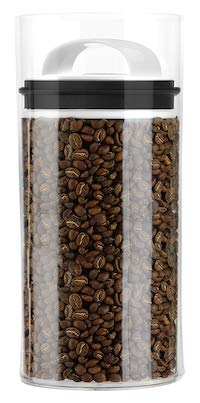
My Keurig B40 coffee maker was super convenient, but throwing those pods in the garbage wasn’t great for the environment (yes, you can compost the contents, but despite manufacturer claims/efforts, you can’t recycle the pods in Toronto. They also limit your coffee choice, so a couple years ago I switched to reusable pods and wrote a blog post about it.
Since then, I learned a couple things about grinding and avoiding leaks that are worth sharing.
Grinding for better (but still convenient, and sometimes cheaper) coffee

Throwaway sealed pods had one thing going for them: freshness. Ground coffee quality decays noticeably as you go through the package. The solution: buy beans and grind them yourself.
There is a daunting amount of material on grinding online, and lots of decisions to be made (I had no idea what “burr grinding” was). In the end, I went with the Krups F203, a blade-based one on the cheaper range. Reviews like this one convinced me it’s the best value for the money: it’s easy to operate and clean, and grinds in about 10 seconds with an acceptable noise level.
You need to get the timing right: too much and the machine can’t push the water; not enough and you don’t get the best flavour. I usually grind enough for 4-6 servings, which can be stored in a small container and last a couple days of working-from-home. An Evak airless container keeps the beans fresh, and the result is good coffee, without much hassle.
Avoiding leaks
I mentioned on the original post the importance of following the instructions, in order to prevent water from flowing from the top of the pod and spill in random directions. Even following those, leaks started to get more frequent - to the point I was considering a coffee maker replacement.
The Keurig system works by having needles perforating the pod from top and bottom. The top needle doubles as the water injection system, and a rubber piece around it exerts pressure on the top of the pod - which creates an efficient seal in traditional pods, but reusables may require some extra pressure, and I suppose they may have deformed the rubber a bit.

While looking for a rubber piece replacement, I found this “EZ Fix - Stop Reusable K Cup Coffee Leaks ad, and decided to try it. It is essentially a pair of tiny rubber discs (the Cafe Cup reusable pods only required one) that lower the machine’s rubber piece to tighten the sealing.
And it works - I had no leaks since I installed it. Granted, you could get such a rubber disc from a local plumbing/hardware shop (1mm height / 3mm hole diameter / 1 cm external diameter should do) or even try an o-ring, but for the price and convenience, I recommend that one. Installation was quick, and (so far 🤞) I had no more leaks.